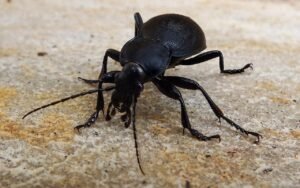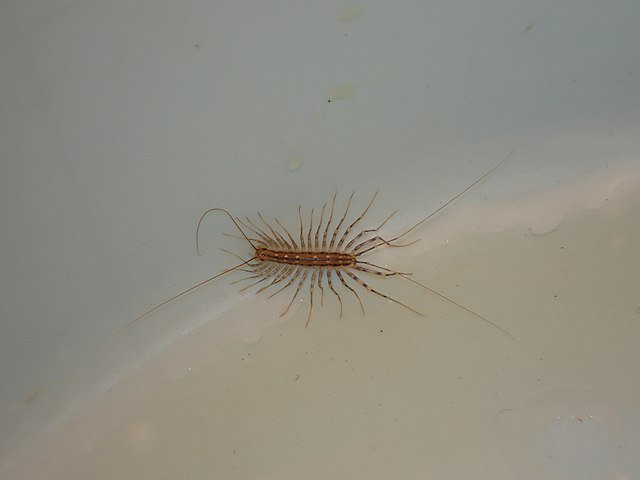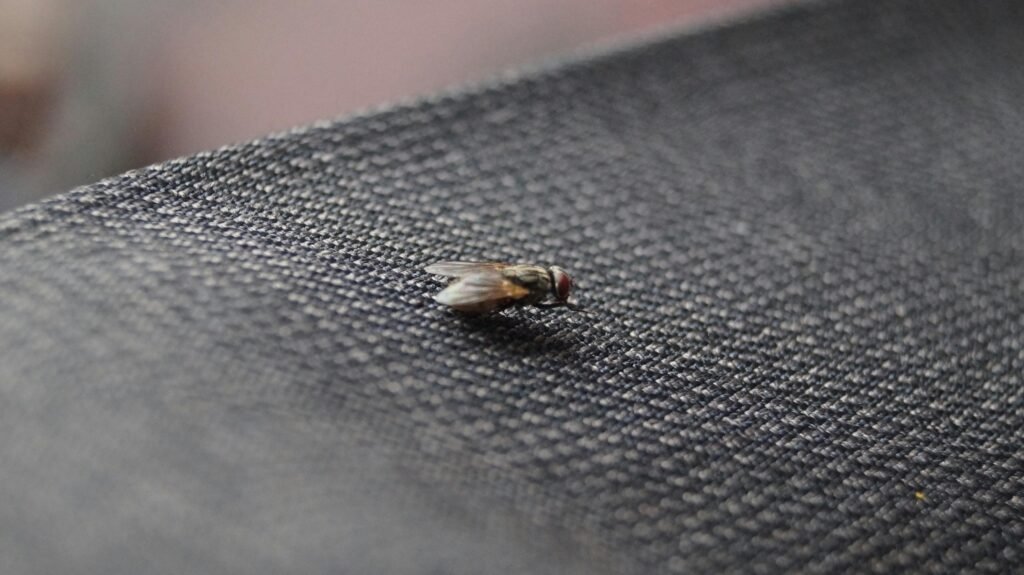Ground Beetles in House and Garden: Identification, Benefits, and Control
 Ground beetles (family Carabidae) are among the most common insects seen around gardens, fields, and sometimes even inside homes. They are fast-moving, usually black beetles that live in soil, under rocks, or beneath leaves. Gardeners often appreciate them as natural pest controllers, but homeowners may get worried when they see them indoors. People frequently ask: Are ground beetles harmful? or How to get rid of ground beetles in the house? This article explains everything you need to know with a focus on both practical advice and scientific background.
Ground beetles (family Carabidae) are among the most common insects seen around gardens, fields, and sometimes even inside homes. They are fast-moving, usually black beetles that live in soil, under rocks, or beneath leaves. Gardeners often appreciate them as natural pest controllers, but homeowners may get worried when they see them indoors. People frequently ask: Are ground beetles harmful? or How to get rid of ground beetles in the house? This article explains everything you need to know with a focus on both practical advice and scientific background.
What Do Ground Beetles Look Like?
Shiny black or dark brown bodies.
Flattened, elongated shape with strong legs for running.
Size varies between 0.5 and 1 inch.
Some species can fly, but most prefer running.
Many are nocturnal and attracted to lights.
Worldwide, there are more than 40,000 known species, with at least 2,000 found in North America alone.
Are Ground Beetles Harmful to Humans?
Ground beetles are not harmful to humans.
They do not bite or sting.
They do not infest food or cause structural damage.
They may release a foul odor when disturbed, but this is harmless.
So if you are searching are ground beetles dangerous to humans, the answer is no. They are beneficial outdoors and only a nuisance if they accidentally wander into houses.
Why Do Ground Beetles Come Into the House?
Ground beetles do not reproduce indoors. If you find them inside, it is usually because:
They are attracted to exterior lights at night.
They enter through gaps in doors, windows, or foundations.
They seek shelter from heat, rain, or storms.
Most indoor appearances are temporary. You are unlikely to see ongoing infestations like with cockroaches.
How to Get Rid of Ground Beetles in the House
People often search for how to get rid of ground beetles in the house fast. The truth is that chemical sprays are rarely necessary. The most effective control comes from prevention and physical removal:
Seal entry points – Use caulk around windows, doors, and the foundation.
Reduce outdoor lighting – Switch to yellow “bug lights” or keep lights away from entrances.
Maintain clean surroundings – Remove piles of leaves, stones, and wood near the house.
Vacuum or sweep indoors – Quick removal is enough since they do not reproduce inside.
If ground beetles appear in very large numbers, you may consider outdoor perimeter treatment by a licensed pest control professional.
Ground Beetles in the Garden: Good or Bad?
Gardeners often wonder: Ground beetles in garden, good or bad? The answer is good.
Ground beetles are natural predators that help with integrated pest management:
They eat slugs, caterpillars, cutworms, aphids, and fly larvae.
They reduce weed seed banks by eating seeds directly.
They improve soil health by balancing insect populations.
This makes them valuable allies for both home gardens and large-scale agriculture.
Life Cycle of Ground Beetles
Understanding their life cycle helps explain when they are most active:
Egg Stage – Eggs are laid in soil during spring or summer.
Larvae – Worm-like, predatory larvae live in soil and feed on insects.
Pupae – Transformation stage inside the soil.
Adults – Emerge fully formed and continue hunting at night.
Most ground beetles live for one to two years, with the majority of activity happening during warmer months.
Different Species Around the World
Ground beetles exist in every major region. Some well-known species include:
North America: Carabus nemoralis and Pterostichus melanarius, both introduced but now widespread.
Europe: Carabus granulatus and Nebria brevicollis, common in farmland and gardens.
Asia: Carabus insulicola in Japan is a large, colorful species.
Australia: Native species like Notonomus gravis play similar ecological roles.
Mentioning these species matters for SEO because people often search for region-specific information.
Defense Mechanisms of Ground Beetles
Ground beetles are mostly harmless to people, but they have fascinating defenses against predators:
Many release foul-smelling chemicals from their abdomen.
Some species, known as bombardier beetles, spray a hot chemical explosion of quinones and hydrogen peroxide.
Their hard exoskeleton and rapid running also protect them.
This makes them efficient survivors in almost any environment.
Ground Beetles vs Other Common Beetles
It is easy to confuse ground beetles with other dark beetles or even cockroaches. Key differences:
Ground beetles: Shiny, flat, long legs, usually found outdoors.
Cockroaches: Flattened body but with long antennae, reproduce indoors, and infest kitchens.
Pantry beetles: Much smaller and usually found in stored food.
This comparison is useful for search queries like difference between ground beetle and cockroach.
Seasonal Activity of Ground Beetles
Spring and Summer – Peak activity outdoors, high hunting of pests.
Fall – More likely to enter houses seeking shelter.
Winter – Many species overwinter as adults under soil or leaf litter.
This seasonal pattern explains why people notice them inside homes more during late summer and autumn.
Ground Beetles in Sustainable Agriculture
Ground beetles are important in integrated pest management (IPM). Farmers encourage them by:
Reducing pesticide use that kills non-target insects.
Creating grassy strips or “beetle banks” that provide shelter.
Leaving crop residues or mulch to increase soil habitat.
Research shows ground beetles can significantly reduce weed seeds and insect pests, lowering the need for chemical inputs.
Homemade Ground Beetle Control
For those who prefer DIY methods:
Soapy water traps – Shallow containers under lights attract and drown beetles.
Sticky traps – Place near doors and windows to prevent entry.
Mulch management – Avoid thick mulch right next to house walls.
These are low-cost and eco-friendly solutions.
Common Myths About Ground Beetles
“Ground beetles bite humans.” False. They are harmless to people.
“They infest houses like cockroaches.” False. Indoor appearances are temporary.
“They damage plants.” Mostly false. They may disturb seedlings rarely, but their overall impact is positive.
Debunking these myths helps answer common search queries and builds trust with readers.
Key Takeaways
Ground beetles are not harmful to humans.
They are beneficial insects that eat pests and weed seeds.
Indoor sightings are temporary and solved with prevention.
If you are asking how to get rid of ground beetles in the house, focus on sealing, cleaning, and reducing lights.
For farmers and gardeners, ground beetles are natural allies in sustainable pest management.
Ιf you found this guide useful, you can explore more in-depth articles on our blog about pest identification, prevention, and safe control methods.
References
Colorado State University – Ground Beetles
https://agsci.colostate.edu/agbio/ipm-pests/ground-beetles/ScienceDirect – Ground Beetles as Biological Control Agents
https://www.sciencedirect.com/science/article/abs/pii/S0167880999000377Waltham Pest Services – Carabid Ground Beetles
https://www.walthamservices.com/blog/carabid-ground-beetles/Better Termite – Black Ground Beetle
https://bettertermite.com/black-ground-beetle/Wikipedia – Ground Beetle
https://en.wikipedia.org/wiki/Ground_beetle
Disclaimer
This article is for informational purposes only. Pest control laws and approved chemicals vary by country. For best results and legal safety, we strongly recommend contacting a licensed pest control professional in your local area. Always make sure that the pest control technician is properly certified or licensed, depending on your country’s regulations. It’s important to confirm that they only use approved products and apply them exactly as instructed on the product label. In most places in Europe, UK, or USA, following label directions is not just best practice—it’s the law.
Author
Nasos Iliopoulos,
MSc Agronomist & Certified Pest Control Expert
Scientific Director, Advance Services (Athens, Greece)
Licensed Pest Control Business – Ministry of Rural Development & Food (GR)


